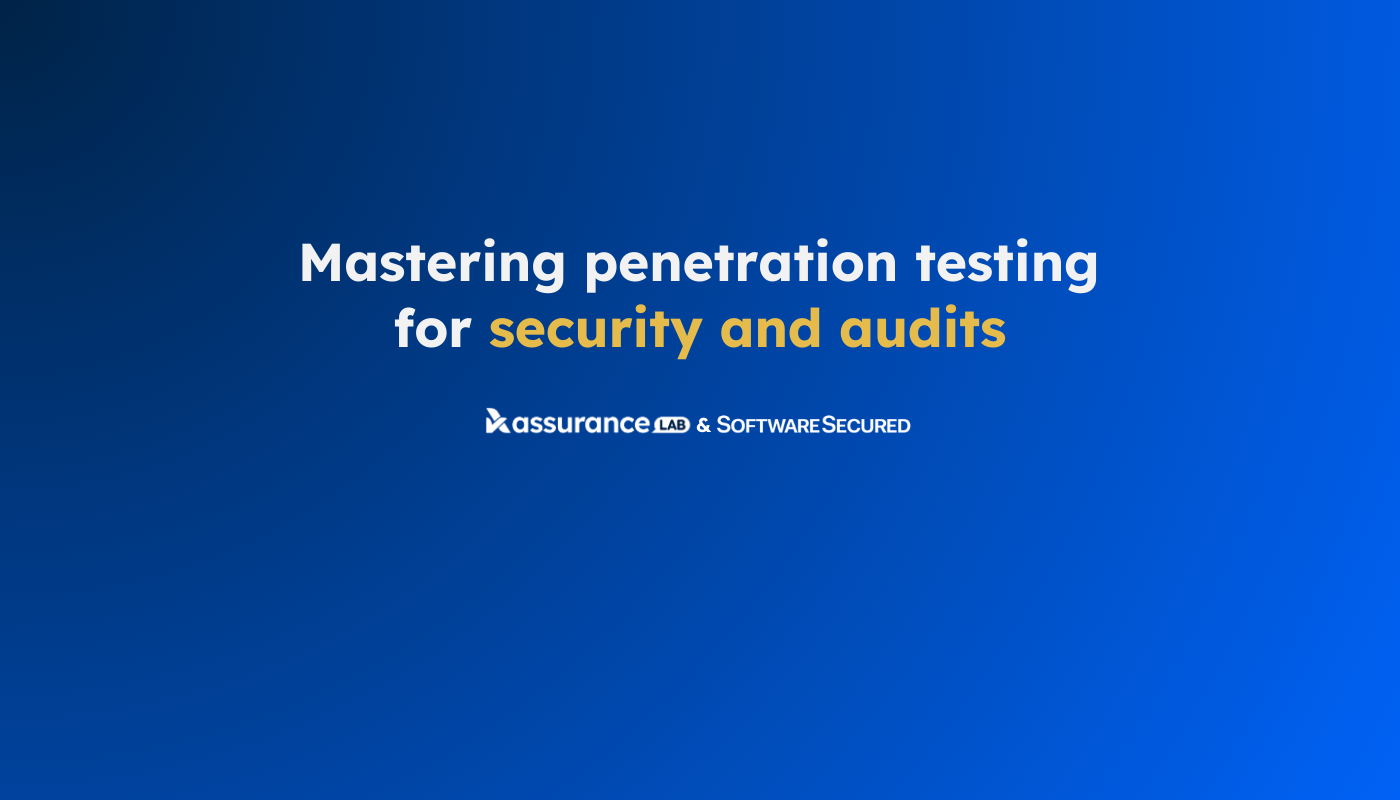
Mastering Pentesting for Security and Audits: A Comprehensive Guide
We worked with Software Secured to create a blog answering all must-know questions on when to start your penetration test.
We worked with Software Secured to create a blog answering all must-know questions on when to start your penetration test.
A penetration test or "pentest" is a comprehensive security test designed to identify vulnerabilities in your web application, mobile application, network, or APIs that an attacker could exploit.
The term penetration testing is so widely used, that it can be hard to tell the difference between a vulnerability scan and a comprehensive manual pentest. Vulnerability scans are automated tools that identify potential weaknesses, while pentests involve skilled professionals actively trying to exploit those vulnerabilities to understand the real risks and impacts on the organization being tested. There are various types of pentesting to address different security and compliance needs. A comprehensive manual pentest goes beyond compliance; it reduces the likelihood of cyber breaches and instills confidence in clients and partners by ensuring their data is secure.
What is Vulnerability Scanning?
Vulnerability scanning typically uses automated tools to identify software, configurations, and network infrastructure vulnerabilities. The results of these scans are compiled into CSV reports that outline the vulnerabilities found and their potential severity. Vulnerability scans can be conducted internally, from within the organization's network, or externally, from outside the organization's network, to provide a high-level view of the security landscape.
Analyzing the Differences Between Comprehensive Pentesting and Vulnerability Scanning
Comprehensive manual penetration tests produce a higher number of vulnerabilities with no false positives. The reports include details, impact, mitigation recommendations, replication steps and evidence. These pentests will meet the most stringent enterprise security and compliance demands (such as SOC 2 and ISO 27001), improve the overall security posture and save developers’ time. A quality pentest firm will offer retesting as a part of the pentest engagement to support remediation following the delivery of the report, ensuring you remediate vulnerabilities that pose a risk to your organization to meet compliance requirements. They will also assist organizations in continuously evaluating the testing frequency and scope to suit evolving business and technical needs. This will assist in completing self-assessments and vendor security questionnaires to maintain and grow your enterprise client base.
The Importance of Pentesting for Security and Audits
Utilizing Pentesting for Enhanced Security Measures
A quality penetration test is crucial for identifying vulnerabilities and assessing the effectiveness of an organization's security measures, particularly as cyber threats grow more sophisticated.
Here are 4 key benefits of a pentest that improve your security posture:
1. Leveraging Early Detection of Vulnerabilities for Improved Security and Sales
Pentests help identify and address security vulnerabilities in production before malicious actors can exploit them. Pentesting in tandem with large new feature releases reduces the risk of the vulnerabilities being exploited and potential financial, legal and reputational risks. While industry statistics indicate that 43% of cybersecurity professionals conduct penetration tests once or twice annually, this frequency may not be sufficient for all organizations. Companies build trust and differentiate themselves in competitive markets by demonstrating a commitment to robust security practices and data protection. At a minimum, annual penetration testing is essential for your growing security strategy.
2. Safeguarding Highly Regulated Sensitive Data and Ensuring Compliance Standards
For organizations handling sensitive information, a pentest helps safeguard sensitive customer data, especially in highly regulated industries (e.g. Finance, Healthcare, Security, and SaaS). Preventing breaches protects the organization's reputation, avoids financial losses from potential breaches, and complies with data protection regulations like GDPR and CCPA as well as compliance frameworks such as SOC 2, HIPAA, and ISO 27001, which require regular pentesting.
Here is a breakdown of compliance framework requirements that can be met with pentesting:
SOC 2:
Both network and application pentesting will fulfill these requirements:
CC1.2, CC3.1, CC3.4, CC4.1, CC4.2, CC5.1, CC5.2, CC7.1
ISO 27001:
GDPR-governed countries expect a pentest and can help you meet these requirements:
A.11, A.12.2.1, A.12.6.1, A.13.2.3, A.14.1, A.12.2.3, A.16.1.3, A.18.2.1, A.18.2.3
HIPAA:
Penetration testing can help meet several HIPAA requirements under both the Security Rule and the Privacy Rule and prevent HIPAA fines.
3. Incident Response Planning
Pentesting identifies vulnerabilities and assesses the organization's incident response capabilities. It helps teams practice detection, response, and recovery processes, improving resilience against future attacks.
4. Targeted Security Investments to Ensure Efficient Return on Investment
By identifying specific weaknesses, a pentest informs more targeted security investments. Rather than spending broadly on security, organizations can focus on areas with the most significant vulnerabilities, making their budget go further. There are 5 ways penetration testing reduces overall security costs, learn how to maximize your security investment ROI here.

Implementing Pentesting for Effective Audit Procedures
Quality penetration testing is a crucial element that audit firms consider when evaluating an organization's security posture. Companies need to collaborate with audit firms that place equal importance on high-quality security measures, such as AssuranceLab. Auditors are trained to adopt a "risk-based" approach, which involves determining the appropriate level of controls to reduce a client's risk to an acceptable level while maintaining compliance. One of the most effective controls for mitigating a client's risk is the implementation of an annual third-party penetration test. When thinking about engaging vendors for a pentest for your audit period, it is best to start engagement 2-3 months before your audit period begins.
When conducting a pentest for auditing purposes, consider these 6 vital elements to ensure your pentest vendor yields valuable results for your audit.
- There is a comprehensive scoping exercise to identify the systems, applications, and networks that will be included in the assessment and their size.
- The vendor creates custom tests based on a client's specific business logic or industry-specific threats like Threat Modelling, as offered by Software Secured.
- The penetration test reports map discovered vulnerabilities to multiple industry frameworks, such as NIST, OWASP Top 10, Sans Top 25, WSTG, and ASVS.
- The pentest report or Portal enables clients to act based on the severity of the identified vulnerabilities.
- Each vulnerability identified is mapped to your Vulnerability Management Policy SLAs so your development teams can prioritize security remediation efforts effectively.
- In cases where a vulnerability requires more developer effort than what is available, the vendor will offer ways to prioritize remediation to mitigate as much risk as possible.
For audit purposes, comprehensive manual penetration testing is essential, along with specific elements such as accurate scoping (similar to your audit scope), custom tests, and actionable reporting, to meet auditor expectations and maintain compliance. This approach ensures that organizations can maintain a strong security posture while balancing their resources and priorities during their audit period. Ultimately, regular penetration testing is indispensable for organizations seeking to protect their assets, meet regulatory requirements, and stay ahead of evolving cyber threats.







